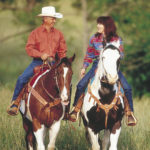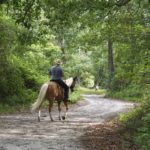In July 2005, the Spanish Riding School came to New Mexico. Two of its most experienced bereiters (riders/trainers) were in Santa Fe to give clinics, and my American Quarter Horse and I were active participants.
The previous September, I had realized a childhood dream by attending two morning workouts at the Spanish Riding School, visiting the museum and touring the stables.
The Spanish Riding School was established in Vienna, Austria, around 1572, and the current Winter Riding School building was completed in 1735. Today, the riders of the SRS cultivate classical equitation, doing dressage movements and airs above the ground on their carefully bred Lipizzan stallions.
But I was a long way from that level of riding. I had been paralyzed with a spinal cord injury from a car accident in 1996. Slowly, I had recovered some ability to move, and horses (via therapeutic riding programs) had been a big part of my recovery.
It’s always nice to have a leg up when you’re ready to get in the saddle. But there are many times when an able-bodied, strong-backed volunteer isn?t available to give you a boost onto your horse. Download your FREE How to Build a Mounting Block report today!
After moving to Santa Fe, I continued equine therapy and met some of the local horse people, including Helen Newton and Terry Berg at Santa Fe Reiners. Although I had ridden dressage since 1973, I tried a quiet western pleasure horse and, with great delight, discovered that I could hold the saddle horn or cantle and feel safe at a slow lope.
I continued to advance, finally able to ride a reining pattern while still holding the saddle, and I again became a horse owner when Helen and Terry found just the right horse in Texas. ?Smoky,? registered as Skippa Crown, had been a 4-H horse who competed in several events.
I rode my new horse a few times in local reining competitions, but I missed dressage. So in September 2004, I started riding Smoky in an English bridle with a simple snaffle, still in my reining saddle.
Smoky was quite happy to go along with the change and progressed rapidly, since he had been trained by excellent people and had that Quarter Horse desire to please. In 2004, I switched to an extremely deep-seated dressage saddle. I trusted Smoky and, by now, was secure enough to canter without holding onto the saddle.
So that was my situation when Herwig Radnetter of the Spanish Riding School taught at Jean Altshuler?s Ashwin Stable just outside of Santa Fe the week of July 11, 2005.
I had early rides, necessary because my body cannot deal with heat. I also was having a periodic problem with my left leg, which was extremely sensitive at the knee and sometimes would spasm uncontrollably away from the saddle.
Herwig was sympathetic to my needs, and the result was excellent rides for both horse and rider. Smoky worked easily on a light contact, round through the neck and steady on the bit. With the direction of ?Herr Herwig,? Smoky moved forward more freely, offering some beautiful working trot and fluid shoulder-ins.
Cantering was more difficult because of my knee problems, but Herwig coached me to sit back a bit more, releasing pressure on my knee. The canter also was less of a problem for me when started from the walk (no problem for a reiner!).
Herwig thought Smoky was a well-suited dressage horse for me, not a fancy warmblood, but a capable horse with an incredible attitude.
Make this mounting block your next 4-H project, or give the plans to the teenagers at your barn to keep them busy! Best of all, this mounting block is easily personalized with paint and decorations. Download your FREE How to Build a Mounting Block report today!
The next week, Andreas Hausberger taught at Karen Berchard?s Pinon Farm south of Santa Fe.
For these sessions, my knee was less sensitive, and I was able to ride more effectively. During trot work, Andreas focused on a strong, round connection to the bit, causing Smoky to engage his hindquarters more and to use his back. Canter work focused on a round frame with a clear three-beat elevated gait.
Andreas was pleased with how well Smoky performed for me, and he thought third-level dressage was a realistic goal.
Both SRS clinicians were sympathetic, kind and warm, besides being excellent teachers and riders. Both thought that this American Quarter Horse was perfect for me, especially with my limitations.
I had never thought I would train with the highly respected riders for the SRS, either before or after my injury. It was an experience better than my wildest dream.





